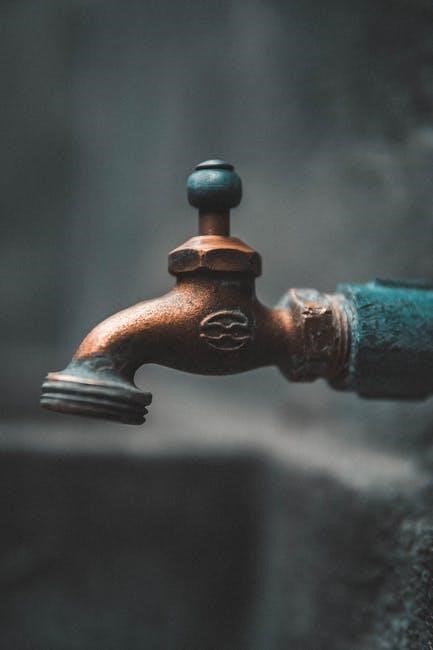A water pipe sizing chart is a guide for determining proper pipe dimensions based on flow rate, pressure, and material. It ensures efficient water distribution and cost savings.
1.1 What is a Water Pipe Sizing Chart?
A water pipe sizing chart is a detailed guide used to determine the appropriate pipe size for water distribution systems. It typically includes information on flow rates, pressure loss, and material types. The chart helps ensure pipes are correctly sized to meet specific demands, avoiding undersizing or oversizing. Proper sizing ensures efficient water flow, reduces energy costs, and prevents system damage. Charts often list pipe diameters, lengths, and maximum flow capacities. They are essential for designers, engineers, and plumbers to plan and install reliable water supply systems. By referencing these charts, professionals can select pipes that balance performance, cost, and durability for residential, commercial, or industrial applications.
1.2 Importance of Proper Pipe Sizing
Proper pipe sizing is crucial for ensuring efficient water flow, minimizing pressure loss, and reducing energy costs. Undersized pipes can lead to increased friction, higher pump costs, and reduced system performance. Oversized pipes, while they reduce pressure loss, can be unnecessarily expensive and may lead to water hammer issues. Correct sizing ensures optimal water velocity, preventing erosion and extending pipe lifespan. It also maintains water quality by avoiding stagnation and contamination risks. Proper sizing is essential for meeting hydraulic demands, ensuring system reliability, and complying with plumbing codes. By using a water pipe sizing chart, professionals can balance cost, performance, and durability, ensuring a safe and efficient water supply system.

Understanding Pipe Sizing Basics
Proper pipe sizing balances flow rate, pressure, and material to ensure efficient water distribution. It involves calculating fixture units, pressure loss, and velocity to select the right pipe diameter.
2.1 Role of Fixture Units in Pipe Sizing

Fixture units are standardized measures representing water demand from plumbing fixtures. Each fixture, like sinks or toilets, has a specific unit value based on its flow rate. By summing these values, engineers determine the total demand for a system. This calculation ensures pipes are sized to handle peak usage without excessive pressure loss. Proper fixture unit allocation prevents undersizing, which can lead to poor performance, and oversizing, which increases costs. Accurate fixture unit assessment is crucial for efficient system design, ensuring reliable water supply and compliance with plumbing codes like UPC and IPC. This step is foundational in creating a water pipe sizing chart.
2.2 Relationship Between Pipe Size and Flow Rate
Pipe size directly influences water flow rate, as larger diameters allow higher volumes to pass with less resistance. Flow rate increases with pipe size due to reduced friction and pressure loss. Charts often display this relationship, helping engineers select appropriate sizes for specific demands. For instance, smaller pipes may suffice for low-flow applications, while larger pipes are needed for high-demand systems. Material type also affects this relationship, as different materials have varying friction coefficients. Understanding this balance ensures efficient system design, avoiding excessive pressure drops and ensuring adequate water supply. Proper sizing optimizes performance, reduces energy costs, and extends system longevity, making it a critical factor in water distribution systems.
Factors Influencing Pipe Sizing
Flow rate, pressure loss, material type, and water velocity are key factors in determining pipe size. These elements ensure efficient water distribution and system performance.
3.1 Flow Rate Requirements
Flow rate is a critical factor in pipe sizing, as it determines the volume of water that needs to be transported. Higher flow rates require larger pipes to prevent pressure loss and ensure adequate supply. The chart helps identify the minimum pipe size needed to maintain desired flow rates without compromising system efficiency. Proper sizing based on flow rate ensures that water pressure remains consistent across the system, preventing issues like low water pressure or excessive velocity, which can lead to pipe damage. By referencing the chart, users can select pipes that meet specific flow requirements, ensuring optimal performance and longevity of the plumbing system.
3.2 Pressure Loss Considerations
Pressure loss, or head loss, is a key factor in water pipe sizing, as it affects system efficiency and performance. It occurs due to friction, fittings, and valves, increasing with flow rate and pipe length. The chart helps calculate pressure loss per hundred feet of pipe, ensuring minimal energy consumption and maintaining adequate water pressure. Proper sizing reduces pressure drop, preventing issues like reduced flow rates and increased pump costs. By considering pressure loss, users can select pipes that balance flow requirements with system efficiency, ensuring reliable water distribution and long-term system performance. This is crucial for both residential and commercial applications, where consistent water pressure is essential.
3.3 Pipe Material and Type

Pipe material and type significantly influence water pipe sizing, as different materials offer varying levels of durability, flexibility, and resistance to corrosion or chemicals. Common materials include PVC, PEX, copper, and galvanized steel, each with unique properties. PVC pipes are lightweight and resistant to corrosion, while PEX offers flexibility and resistance to freezing. Copper pipes are durable but more expensive, and galvanized steel is strong yet prone to rust over time. The chart provides sizing guidelines for these materials, ensuring compatibility with specific applications. Selecting the right material and type is crucial for system longevity, efficiency, and compliance with local codes. Proper material selection also impacts flow rates and pressure loss, making it a critical factor in pipe sizing decisions.
3.4 Water Pressure and Velocity
Water pressure and velocity are critical factors in pipe sizing, as they directly impact flow rates and system performance. Higher pressure and velocity can lead to increased head loss, affecting the overall efficiency of the water distribution system. The sizing chart helps determine the appropriate pipe diameter to maintain optimal flow velocity, typically between 2-8 feet per second for residential systems, to minimize wear and noise. Proper balancing of pressure and velocity ensures that the system operates efficiently without excessive energy loss or potential damage. This balance is essential for maintaining water quality, preventing erosion, and ensuring consistent pressure across the entire system. Accurate calculations using the chart are vital for achieving these goals.
How to Read a Water Pipe Sizing Chart
A water pipe sizing chart helps determine the correct pipe diameter by correlating flow rate, pressure, and material. It ensures optimal water distribution and system efficiency.
4.1 Understanding Chart Layout
A water pipe sizing chart is typically organized with flow rate on one axis and pipe size on the other. The chart displays head loss per hundred feet of pipe, helping users select the right diameter for their system. It often includes data for various materials like PVC and polyethylene. Users can identify the required pipe size by matching their system’s flow rate and pressure requirements. The layout may also feature multiple rows or columns for different pipe materials, ensuring compatibility and accuracy. By understanding the chart’s structure, professionals can efficiently determine the optimal pipe size, minimizing pressure drop and ensuring efficient water flow.
4.2 Interpreting Pipe Sizes and Ratings
Interpreting pipe sizes and ratings from a water pipe sizing chart involves understanding the relationship between pipe diameter, flow rate, and pressure. Pipe sizes are typically listed in nominal or actual diameters, with corresponding flow rates and pressure ratings. The chart may include multiple rows for different materials, such as PVC or polyethylene, each with unique ratings. Users should identify their system’s flow rate and desired pressure to select the appropriate pipe size. Proper interpretation ensures the pipe can handle the required flow without excessive pressure loss. Misreading the chart can lead to undersized or oversized pipes, affecting system efficiency and longevity. Always cross-reference with material specifications for accuracy.

Common Pipe Materials for Water Systems
Common materials include PVC, PEX, copper, and polyethylene, each offering durability, resistance to corrosion, and suitability for varying water pressure and flow rate requirements.
5.1 PVC Pipe Sizing
PVC pipes are widely used in water systems due to their durability and resistance to corrosion. Sizing PVC pipes involves considering flow rate, pressure, and material thickness. Charts provide head loss per hundred feet, helping determine the appropriate size for specific applications. PVC pipes are cost-effective and suitable for low-to-medium pressure systems. They are commonly used in residential and commercial plumbing due to their ease of installation and long lifespan. Proper sizing ensures efficient water flow and minimizes pressure drop, which is critical for system performance. Always refer to manufacturer guidelines and local codes for accurate PVC pipe sizing in water supply systems.
5.2 Copper Pipe Sizing
Copper pipes are durable and ideal for high-pressure and high-temperature water systems. Sizing copper pipes involves calculating flow rates, pressure loss, and tube thickness. Charts provide head loss per hundred feet for various sizes and flow rates, ensuring proper sizing. Copper pipes are commonly used in residential and commercial plumbing due to their reliability and long lifespan. Proper sizing is crucial to maintain water pressure and flow efficiency. Always consult local plumbing codes and manufacturer guidelines for accurate copper pipe sizing in water supply systems. This ensures system performance, safety, and compliance with regulations.
5.3 PEX Pipe Sizing
PEX (cross-linked polyethylene) pipes are flexible and resistant to freezing, making them ideal for water systems. Sizing PEX pipes involves considering flow rates, pressure, and tube size. Charts provide head loss per hundred feet for various sizes and flow rates, ensuring proper sizing. PEX pipes are widely used in residential and commercial plumbing due to their durability and ease of installation. Proper sizing is essential to maintain water pressure and flow efficiency. Always consult local plumbing codes and manufacturer guidelines for accurate PEX pipe sizing in water supply systems. This ensures system performance, safety, and compliance with regulations.
Applications of Water Pipe Sizing Charts
Water pipe sizing charts are essential for designing efficient plumbing systems in residential, commercial, and industrial settings, ensuring optimal water flow and pressure for various applications.
6.1 Residential Plumbing Systems
Water pipe sizing charts are crucial for residential plumbing systems, ensuring adequate water supply to fixtures like sinks, showers, and toilets. By calculating fixture units and flow rates, charts help determine the correct pipe diameters to maintain optimal water pressure. Proper sizing prevents issues like low water pressure or excessive noise. Materials such as PEX, copper, and PVC are commonly used, with charts providing guidance on their suitability for specific applications. Compliance with codes like the Uniform Plumbing Code (UPC) and International Plumbing Code (IPC) is essential. Accurate pipe sizing ensures energy efficiency, reduces wear and tear, and supports long-term system reliability in homes.
6.2 Commercial Plumbing Systems
Water pipe sizing charts are essential for commercial plumbing systems, where scaling is critical to meet high demand. These charts help determine appropriate pipe sizes based on flow rates, pressure loss, and material compatibility. In commercial settings, accurate sizing ensures consistent water pressure across fixtures, reducing the risk of system inefficiencies. Compliance with codes like the Uniform Plumbing Code (UPC) and International Plumbing Code (IPC) is mandatory. Proper sizing also minimizes energy consumption and operational costs. Tools like pipe sizing calculators and charts simplify the process, ensuring reliability and performance in large-scale systems. This approach supports long-term functionality and efficiency in commercial environments.
6.3 Industrial Water Supply Systems
Water pipe sizing charts are crucial for industrial water supply systems, where precise sizing ensures optimal performance and efficiency. These charts help determine the appropriate pipe diameters for high-flow applications, minimizing head loss and pressure drops. Industrial systems often require durable materials like PVC and polyethylene, which are rated for high pressure and chemical resistance. Compliance with codes such as the Uniform Plumbing Code (UPC) and International Plumbing Code (IPC) is essential. Proper sizing reduces energy costs and extends system lifespan. Tools like pipe sizing calculators and charts enable accurate planning. Regular maintenance and inspections further ensure reliability, making these charts indispensable for industrial water management.

Codes and Standards for Pipe Sizing
Codes like UPC and IPC provide guidelines for water pipe sizing, ensuring safety and efficiency. ASTM standards regulate pipe materials, while local codes may add specific requirements.
7.1 Uniform Plumbing Code (UPC) Guidelines
The Uniform Plumbing Code (UPC) provides comprehensive guidelines for water pipe sizing, ensuring safe and efficient water distribution systems. It outlines methods for calculating pipe sizes based on fixture units, which represent the flow demands of various plumbing fixtures. The UPC also addresses flow rate requirements and pressure loss, helping to determine the appropriate pipe diameter for different applications. Additionally, it includes tables and charts for sizing pipes under various conditions, such as water pressure and temperature. By following UPC guidelines, plumbers can ensure compliance with safety standards and optimize system performance. These guidelines are regularly updated to reflect advancements in plumbing technology and materials.
7.2 International Plumbing Code (IPC) Requirements
The International Plumbing Code (IPC) provides detailed requirements for water pipe sizing, focusing on safety, efficiency, and compliance. It includes methods for sizing water supply pipes based on flow rate demands and pressure drop. The IPC addresses various piping materials and their compatibility with different water systems. Appendix E of the IPC specifically outlines water pipe sizing procedures, offering tables and charts to guide plumbers. The code also emphasizes the importance of considering fixture units and system demand when selecting pipe sizes. By adhering to IPC standards, professionals ensure reliable water distribution while meeting local and international regulations. Regular updates to the IPC reflect advancements in plumbing practices and materials.

7.3 ASTM Standards for Pipe Materials
ASTM standards provide detailed specifications for pipe materials, ensuring their quality and performance in water systems. These standards cover dimensions, tolerances, and testing methods for materials like PVC, polyethylene, and others. ASTM guidelines help in selecting pipes that meet specific flow rate and pressure requirements. For instance, ASTM standards for PVC pipes include specifications for impact resistance and chemical compatibility. Similarly, polyethylene pipes are evaluated for durability and flexibility. By adhering to ASTM standards, professionals can ensure that pipes are suitable for their intended applications. These standards are often referenced in water pipe sizing charts to guarantee safe and efficient water distribution systems. Regular updates to ASTM standards reflect advancements in material technology and plumbing practices.

Tools and Resources for Pipe Sizing
Online calculators, mobile apps, and printable charts streamline pipe sizing calculations, ensuring accuracy and efficiency in water system design and installation.
8.1 Online Pipe Sizing Calculators
Online pipe sizing calculators are powerful tools that simplify the process of determining the correct pipe dimensions for water systems. These calculators typically require input parameters such as flow rate, pressure drop, and pipe material. They use complex algorithms to provide precise sizing recommendations, ensuring optimal system performance. Many calculators are available for free or through subscription-based platforms, catering to both residential and commercial applications. They often include features like dynamic charts, real-time calculations, and compatibility with various plumbing codes. By leveraging these tools, professionals can save time, reduce errors, and ensure compliance with local regulations. They are indispensable for modern plumbing design and installation projects.

8.2 Mobile Apps for Plumbing Calculations
Mobile apps for plumbing calculations offer convenient, on-the-go solutions for sizing water pipes and performing related tasks. These apps provide user-friendly interfaces for inputting data such as flow rates, pressures, and pipe materials. Many apps, like those demonstrated by Quin Williams, support calculations for PEX, copper, and PVC pipes. They often include real-time sizing recommendations, ensuring accuracy and efficiency. Some apps align with plumbing codes like the Uniform Plumbing Code (UPC), helping professionals meet regulatory requirements. By streamlining complex calculations, these tools save time and reduce errors. They are essential for plumbers, contractors, and engineers working on residential or commercial projects, offering portability and accessibility for fieldwork.
8.3 Printable Pipe Sizing Charts
Printable pipe sizing charts are essential tools for plumbers and engineers, offering a quick reference for determining appropriate pipe sizes. These charts typically display data such as flow rates, pressure losses, and pipe diameters for various materials like PVC, PEX, and copper. They often align with plumbing codes, ensuring compliance with safety and efficiency standards. Many charts, such as those for PVC and polyethylene pipes, provide head loss calculations in feet or meters per hundred feet. These documents are ideal for fieldwork or pre-planning, allowing professionals to select the right pipe size without relying on digital tools. Printable charts are versatile, catering to residential, commercial, and industrial applications, and are widely available online for easy access.
Best Practices for Implementing Pipe Sizing Charts
Always consult local plumbing codes and consider future system expansion when using pipe sizing charts. Regular maintenance ensures optimal performance and longevity of water systems.
9.1 Consulting Local Plumbing Codes
Consulting local plumbing codes is essential for accurate pipe sizing. Codes like the Uniform Plumbing Code (UPC) and International Plumbing Code (IPC) provide region-specific guidelines. These codes ensure compliance with safety standards, water efficiency, and system performance. They outline requirements for fixture units, flow rates, and pressure loss. Local regulations may vary due to climate, water availability, and infrastructure. Adhering to these codes helps avoid legal issues and ensures system reliability. Always verify the latest updates and amendments to stay compliant. This step is crucial for both residential and commercial plumbing systems, ensuring water distribution meets local standards and user demands effectively.
9.2 Considering Future System Expansion
Considering future system expansion is crucial when using a water pipe sizing chart. It ensures scalability and flexibility for potential increases in water demand. Planning for future additions, such as new fixtures or users, prevents costly upgrades. Proper pipe sizing today accommodates future needs without compromising current performance. This approach minimizes the need for system overhauls and ensures long-term reliability. Always account for potential growth when selecting pipe sizes and materials. A forward-thinking strategy saves time and resources while maintaining water efficiency and system integrity. This proactive method is essential for both residential and commercial plumbing systems, ensuring they remain adaptable and functional over time.
9.3 Regular Maintenance and Inspection
Regular maintenance and inspection are vital for ensuring the longevity and efficiency of water systems. Using a water pipe sizing chart during inspections helps verify that the system operates within design parameters. Over time, factors like corrosion, sediment buildup, and wear can alter pipe performance. Routine checks allow early detection of issues, preventing leaks, blockages, and pressure drops. Inspecting pipe sizes and materials against the chart ensures compliance with original specifications. Maintenance also involves cleaning and replacing worn components, ensuring optimal flow rates and water pressure. Regular inspections by professionals can identify potential failures before they occur, safeguarding the system’s reliability and performance over time.
Proper water pipe sizing ensures efficiency, safety, and cost-effectiveness in plumbing systems. Using charts and best practices guarantees reliable performance and long-term system integrity.

10.1 Summary of Key Points
A water pipe sizing chart is essential for ensuring efficient water distribution. It helps determine the correct pipe size based on flow rate, pressure, and material. Proper sizing prevents issues like low water pressure or excessive noise. The chart considers factors such as fixture units, which represent water demand from appliances. Understanding the relationship between pipe size and flow rate is critical for optimal system performance. Additionally, pressure loss and velocity must be accounted for to maintain water quality and system longevity. By following these guidelines, plumbers can design reliable and cost-effective water supply systems. Regular updates to codes and standards ensure safety and compliance. Proper pipe sizing is a cornerstone of modern plumbing.
10.2 Final Thoughts on Effective Pipe Sizing
Effective pipe sizing is crucial for ensuring reliable water supply systems. Proper sizing balances flow rate, pressure, and material durability, preventing issues like low pressure or contamination. Using tools like sizing charts and calculators simplifies the process. Always consult local plumbing codes and consider future system expansion. Regular maintenance ensures long-term performance. By adhering to best practices, plumbers can create efficient, safe, and cost-effective water distribution systems. Proper pipe sizing is not just a technical requirement but a foundation for sustainable and resilient plumbing solutions; It ensures water quality, reduces energy consumption, and minimizes operational costs over time. Accurate sizing is a key investment in system longevity and user satisfaction.
